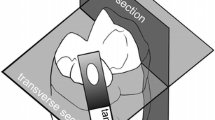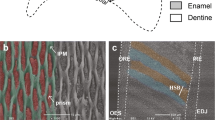Abstract
Enamel distribution on the upper and lower incisors ofTribosphenomys minutus (from Late Paleocene-Early Eocene of Inner Mongolia of China) is typically rodent-like, i.e., primarily confined to the anterior surface throughout these transversely compressed, evergrowing teeth. AlthoughTribosphenomys incisor enamel is differentiated into two layers, it does not possess Hunter-Schreger bands (HSB). The incisor and molar enamels are radial in type, a condition regarded as either an autapomorph or a primtive retention forTribosphenomys. Character polarities concerning enamel thickness, enamel layer number, HSB, enamel types, and functional and phylogenetic implications of the enamel structures are discussed. Overall, enamel microstructural evolution at high taxonomic levels within Glires displays considerably more homoplasy than generally appreciated. A phylogenetic definition of Rodentia is proposed.Tribosphenomys is the sister-group of a taxon here named “Rodentia,” and thus is not itself a member of the order, from a systematic viewpoint.
Similar content being viewed by others
Literature Cited
Bleefeld, A. R., and McKenna, M. C. (1985). Skeletal integrity ofMimolagus rodens (Lagomorpha, Mammalia).Am. Mus. Novit. 2806: 1–5.
Boyde, A. (1976). Enamel structure and cavity margins.Operative Dentistry 1: 13–28.
Carlson, S. J., and Krause, D. W. (1985). Enamel ultrastructure of multituberculate mammals: An investigation of variability.Cont. Mus. Paleont., The University of Michigan 27: 1–50.
Dashzeveg, D. (1990a). The earliest rodents (Rodentia, Ctenodactyloidea) of Central Asia.Acta Zool. Cracov. 33: 11–35.
Dashzeveg, D. (1990b). New trends in adaptive radiation of early Tertiary rodents (Rodentia, Mammalia).Acta Zool. Cravov 33: 37–44.
Dashzeveg, D., Russell, D. E., and Flynn, L. J. (1987). New Glires (Mammalia) from the early Eocene of the People's Republic of Mongolia. 1. Systematics and description.Proc. Koninkl. Akad. Wetensch. B90: 133–142.
Dashzeveg, D., and Russell, D. E. (1988). Palaeocene and Eocene Mixodontia (Mammalia. Glires) of Mongolia and China.Palaeontology 31: 129–164.
de Queiroz, K. (in press). Definition of the name “Mammalia” and the replacement of an essentialist perspective on taxonomic definitions.Syst. Biol.
de Queiroz, K., and Gauthier, J. (1990). Phylogeny as a central principle in taxonomy: Phylogenetic definitions of taxon names.Syst. Biol. 39(4): 307–322.
de Queiroz, K., and Gauthier, J. (1992). Phylogenetic taxonomy.Ann. Rev. Ecol. Syst. 23: 449–480.
Flynn, L. J. (1994). Roots of rodent radiation.Nature 370: 97–98.
Flynn, L. J., Jacobs, L. L., and Cheema, I. U. (1986). Baluchimyinae, a new ctenodactyloid rodent subfamily from the Miocene of Baluchistan.Am. Mus. Novitates 2841: 1–58.
Flynn, L. J., Russell, D. E., and Dashzeveg, D. (1987). New Glires (Mammalia) from the early Eocene of the People's Republic of Mongolia. 2. Incisor morphology and enamel microstructure.Proc. Koninkl. Akad. Wetensch. B 90: 143–154.
Hartenberger, J.-L. (1985). The order Rodentia: Major question on their evolutionary origin, relationships and suprafamilial systematics. In:Evolutionary Relationships Among Rodents, W. P. Luckett and J.-L. Hartenberger, eds., pp. 1–33, Plenum Press, New York.
Koenigswald, W. v. (1980). Schmelzmuster und Morphologie in den Molaren der Arvicolidae (Rodentia).Abh. Senckenb. naturf. Ges. 539: 1–129.
Koenigswald, W. v. (1985). Evolutionary trends in the enamel of rodent incisors. In:Evolutionary Relationships among Rodents, W. P. Luckett and J.-L. Hartenberger, eds., pp. 403–422, Plenum Press, New York.
Koenigswald, W. v. (1988). Enamel modification in enlarged front teeth among mammals and the various possible reinforcements of the enamel.Mém. Mus. Natl. Hist. Nat. C53: 148–165.
Koeingswald, W. v., and Clemens, W. A. (1992). Levels of complexity in the microstructure of mammalian enamel and their application in studies of systematics.Scan. Microsc. 6(1): 195–218.
Koenigswald, W. v., and Pfretzschner, H. U. (1991). Biomechanics in the enamel of mammalian teeth. In:Constructional Morphology and Biomechanics, N. Schmidt-Kittler and K. Vogel, eds., pp. 113–125, Springer-Verlag, Berlin and Heidelberg.
Koenigswald, W. v., Rensberger, J. M., and Pfretzschner, H. U. (1987). Changes in the tooth enamel of early Paleocene mammals allowing increased diet diversity.Nature 328: 150–152.
Koenigswald, W. v., Sander, P. M., Leite, M. B., Mörs, T., and Santel, W. (1994) Functional symmetries in the schmelzmuster and morphology of rootless rodent molars.Zool. J. Linn. Soc. 110: 141–179.
Korvenkontio, V. A. (1934). Mikroskopische Untersuchungen an Nagerincisiven unter Hinweis auf die Schmelzstruktur der Backenzähne.Ann. Zool. Soc. Zool.-Bot. Fenn. Vanano 2: 1–274.
Li, C.-K. (1977). Paleocene eurymyloids (Anagalida, Mammalia) of Quianshan, Anhui.Vert. PalAsiat. 15: 103–118.
Li, C.-K., and Chow, M.-C. (1994). The origin of rodents. In:Rodent and Lagomorph Families of Asian Origins and Diversification, Y. Tomida, C.-K. Li, and T. Setoguchi, eds., pp. 15–18, National Science Museum Monographs 8, Tokyo.
Li, C.-K., and Ting, S.-Y. (1985). Possible phylogenetic relationships of eurymylids and rodents, with comments on mimotonids. In:Evolutionary Relationships Among Rodents, W. P. Luckett and J.-L. Hartenberger, eds., pp. 35–58, Plenum Press, New York.
Li, C.-K., and Ting, S.-Y. (1993). New cranial and postcranial evidence for the affinities of the eurymylids (Rodentia) and mimotonids (Lagomorpha). In:Mammal Phylogeny-Placentals, F. S. Szalay, M. J. Novacek, and M. C. McKenna, eds., pp. 151–158, Springer-Verlag, New York.
Li, C.-K., Wilson, R. W., Dawson, M. R., and Krishtalka, L. (1987). The origin of rodents and lagomorphs. In:Current Mammalogy (Vol. 1), H. H. Genoways, ed., pp. 97–108. Plenum Press, New York.
Li, C.-K., and Yan, D.-F. (1979). The systematic position of eurymylids (Mammalia) and the origin of Rodentia. In:Abstracts of Papers, 12th Annual Conference and 3rd National Congress Paleontological Society of China, pp. 155–156, Beijing.
Li, C.-K., Zheng, J.-J., and Ting, S.-Y. (1989). The skull ofCocomys lingchaensis, an early Eocene ctenodactyloid rodent of Asia. In:Papers on Fossil Rodents in Honour of Albert Elmer Wood, C. C. Black and M. Dawson, eds., pp. 179–192, Los Angeles County Museum, Los Angeles.
Luckett, W. P., and Hartenberger, J.-L. (1993). Monophyly or polyphyly of the Order Rodentia: Possible conflict between morphological and molecular interpretations.J. Mam. Evol. 1: 127–147.
Martin, T. (1992). Schmelzstruktur in den Inzisiven alt—und neuweltlicher hystricognather Nagetiere.Palaeovertebrata Mém. extra. 1–168.
Martin, T. (1993). Early rodent incisor enamel evolution: Phylogenetic implications.J. Mam. Evol. 1: 227–254.
McKenna, M. C. (1982). Lagomorpha interrelationships. In: Phylogénie et Paléobiogéographie. Livre jubilaire en l'honneur de Robert Hoffstetter.Géobios, mém. spéc. 6: 213–224.
McKenna, M. C. (1993). Cranial features of mimotonid lagomorphs.J. Vert. Paleont. 13: (Suppl.) 50A.
Meng, J., Wyss, A. R., Dawson, M. R., and Zhai, R.-J. (1994). Primitive fossil rodent from Inner Mongolia and its implications for mammalian phylogeny.Nature 370: 134–136.
Pfretzschner, H. U. (1988). Structural reinforcement and crack propagation in enamel.Mém. Mus. Natl. Hist. Nat. Paris C 53: 133–143.
Rensberger, J. M., and Koenigswald, W. v. (1980). Functional and phylogenetic interpretation of enamel microstructure in rhinoceroses.Paleobiology 6: 477–495.
Russell, D. E., and Zhai, R.-J. (1987). The Palaeogene of Asia: Mammals and stratigraphy.Mém. Mus. Nat. d'Hist. Nat. Series C, Sciences de la Terre 52: 1–488.
Sahni, A. (1985). Enamel structure of early mammals and its role in evaluating relationships among rodents. In:Evolutionary Relationships Among Rodents, W. P. Luckett and J.-L. Hartenberger, eds., pp. 133–150. Plenum Press, New York.
Simpson, G. G. (1945). The principles of classification and a classification of mammals.Bull. Amer. Mus. Nat. Hist. 85: 1–350.
Stern, D., Crompton, A. W., and Skobe, Z. (1989). Enamel ultrastructure and masticatory function in molars of the American opossum,Didelphis virginiana.Zool. J. Linn. Soc. London 95: 311–334.
Sych, L. (1971). Mixodontia, a new order of mammals from the Paleocene of Mongolia.Pal. Polonica 25: 147–158.
Tomes, J. (1850). On the structure of the dental tissues of the order Rodentia.Phil. Tran. Roy. Soc. Lond. 1850: 529–567.
Tong, Y.-S., and Dawson, M. R. (in press). Early Eocene rodents (Mammalia) from Shangdong Province, China.Ann. Carnegie Mus.
Wahlert, J. H. (1984). Hystricomorphs, the oldest branch of the Rodentia.Ann. N. Y. Acad. Sci. 435: 356–357.
Wahlert, J. H. (1989). The three types of incisor enamel in rodents.Nat. Hist. Mus. Los Angeles Co. Sci. Ser. 33: 7–16.
Wood, A. E., (1962). The early Tertiary rodents of the family Paramyidae.Trans. Am. Phil. Soc. 52: 1–261.
Author information
Authors and Affiliations
Rights and permissions
About this article
Cite this article
Meng, J., Wyss, A.R. Enamel microstructure ofTribosphenomys (Mammalia, glires): Character analysis and systematic implications. J Mammal Evol 2, 185–203 (1994). https://doi.org/10.1007/BF01473528
Issue Date:
DOI: https://doi.org/10.1007/BF01473528




